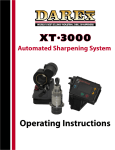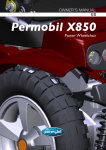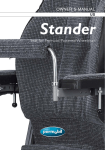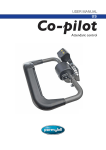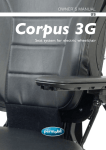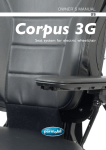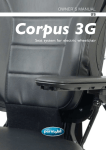Download 5 - Permobil
Transcript
USER MANUAL US ESP Enhanced Steering Performance ESP Enhanced Steering Performance Produced and published by Permobil AB, Sweden Edition 2, 2008-1 Product code: 205008-US-0 How to contact Permobil Head Office of the Permobil group ESP User Manual Contents Contents Introduction .................................................................................................... 6 Safety rules.................................................................................................... 7 Programming ................................................................................................ 8 Parameter settings ........................................................................................ 9 Program version .......................................................................................... 10 Troubleshooting .......................................................................................... 10 Resetting the factory settings and calibrating the sensor ............................11 5 ESP User Manual Introduction Introduction The task of the ESP module is to give your wheelchair safer driving properties. ESP stands for Enhanced Steering Performance. The ESP module is programmed by Permobil to give the wheelchair optimum performance. Customization may mean that small adjustments are necessary afterwards. Adjustments to the preprogrammed parameters may only be made by an engineer with good knowledge of the ESP module. The ESP module is installed on the wheelchair chassis. See the chassis service manual for further information. The ESP module is connected between the wheelchair actuator and the output stage, Pilot+. The module contains a sensor that measures the wheelchair’s course deviations. A processor uses the information to correct any deviations from the course the user set using the wheelchair actuator. The ESP module uses the information from the sensor and the actuator to calculate a correct control signal. The control signal is then passed to the wheelchair output stage, Pilot+, which controls the drive motors. Operation of the ESP module requires access to the full capacity of the output stage. Pilot+’s various parameters therefore need to be adjusted to predefined values to guarantee full maneuverability. NB. The parameters in the Pilot+ output stage are set by Permobil and must not be changed. If changes need to be made to the wheelchair properties, they must be made via adjustments to the ESP module. The ESP module has built-in functions to control wheelchair performance, acceleration, course stability, etc. 6 ESP User Manual Safety rules Safety rules - No changes may be made to the Pilot+ output stage parameters. Reprogramming with PP1c, ESP PC Programmer or similar equipment may not take place. - The ESP module may only be programmed by engineers who have good knowledge of ESP functions. - Changes made to the parameters of the ESP module must be documented. Note the values of the parameters before and after changes. - The ESP module is supplied preprogrammed for best performance. Any change to a parameter’s value should mean a reduction in the value. Increasing a parameter’s value may cause the wheelchair to become unstable and hard to maneuver. - When changes have been made to the ESP module parameters, the wheelchair must be test-driven before it is returned to the user. NB. If tests are carried out with the ESP module disconnected, you should be aware that the control characteristics are set to very high values. This makes the wheelchair hard to maneuver. Ensure that there is adequate free space around the wheelchair where the test is carried out. 7 ESP User Manual Programming Programming The ESP module has 16 adjustable parameters. Changes are made to the values of the parameters using three buttons on the front of the module. The ESP module is installed on the wheelchair chassis For further information on its location, see the chassis service manual. 1. Hold down the “S” button while starting the wheelchair with the main power switch on the control panel. The ESP module display displays “P1”. NB If the wheelchair has an additional joystick, the ESP module display displays “CJ” for a short while. This means that the joystick’s neutral position is being calibrated. Ensure that the joystick is in its neutral position on startup. If it is not, the calibration will fail and the error code “E6” will be displayed. Error codes are discussed on page 10. 2. Release the “S” button. The display displays “01”, which means parameter no. 1. 3. Using the plus or minus button, you can step through the various parameters. 4. Press the “S” button to read the value for the parameter selected. 5. Using the plus or minus button, you can increase or reduce the value of the parameter selected. 6. Press the “S” button to save the value set. The display returns to displaying the parameter number. 7. Scroll with the plus or minus button to another parameter. 8. Exit the programming mode by switching off the wheelchair with the main power switch on the control panel. ERROR CODES E1: OMNI+/JOYSTICK+ E2: DATA TIME OUT E3: SENSOR E4: PROCESSOR ADC E5: ATT JOYSTICK E6: EPROM E7: INTERNAL/CODE E8: WATCHDOG ESP Module-JS S ESP module front panel. 8 + - ESP User Manual Programming & parameter settings Example: The wheelchair is too fast in speed position 5. To reduce the maximum speed, go to the programming mode and step to parameter 9. Press the “S” button to see the current setting. Adjust the value downwards using the minus button. Save the value set by again pressing the “S” button. Switch off and then start the wheelchair with the main power switch on the control panel to test-drive the wheelchair. Remember that the maximum speed is reduced if the seat lift is raised. The seat lift must, therefore, be in its lowest position during the test drive. Parameter settings Number Standard Range* Min. Max. Step Designation 1 15 10 - 75 5 95 5 Max. acceleration (speed 5) 2 15 5 - 50 5 95 5 Max. acceleration (speed 1) 3 75 20 - 75 5 95 5 Max. deceleration (speed 5) 4 30 10 - 70 5 95 5 Max. deceleration (speed 1) 5 40 25 - 75 5 95 5 Max. turn acceleration (speed 5) 6 15 10 - 50 5 95 5 Min. turn acceleration (speed 1) 7 60 35 - 80 5 95 5 Max. turn deceleration (speed 5) 8 40 30 - 60 5 95 5 Min. turn deceleration (speed 1) 9 95 20 - 95 5 95 5 Max. forward speed (speed 5) 10 15 10 - 80 5 95 5 Min. forward speed (speed 1) 11 25 10 - 50 5 95 5 Max. reverse speed (speed 5) 12 10 10 - 30 5 95 5 Min. reverse speed (speed 1) 13 80 50 - 90 5 95 5 Max. turning speed (speed 5) 14 65 25 - 80 5 95 5 Min. turning speed (speed 1) 15 2 N/A 1 5 1 Attendant high speed selection 16 1 N/A 1 5 1 Attendant low speed selection * Recommended range for most users. 9 ESP User Manual Program version & troubleshooting Program version The ESP module program version is displayed in the display for a second when the wheelchair is started using the main power switch on the control panel. Example: The ESP module display displays 60 on startup. This means that the ESP module has program version 6.0. Troubleshooting When the wheelchair electronics system indicates an error in the output stage, it may also be the ESP module that found an error. The ESP module troubleshoots all vital parts continuously. If an error is found, the wheelchair stops and an error code is displayed in the ESP module display. When the error code has been read off, suitable action can be taken according to the table below. Error code Designation E1 OMNI+/Joystick + Control panel sending Control panel error message E2 Data time out Interruption in data communication ESP module, cables, control panel or output stage E3 Sensor Sensor error ESP module E4 Processor ADC Sensor error ESP module E5 Att Joystick Additional joystick error Additional joystick E6 EPROM EPROM data error ESP module, reset factory settings, calibrate E7 Internal/Code Software code error ESP module E8 Watchdog Processor error ESP module E9 Profile change Operating error Switch off the main power switch on the control panel. Switch it on again. Remark 10 Check and/or replace ESP User Manual Resetting and calibrating Resetting the basic settings and calibrating the sensor Calibrate the sensor and return to the settings the ESP module had on delivery from Permobil: - if the wheelchair does not keep a sufficiently straight course when driven forwards. - after problems with EPROM data. Error code E6, see page 10. Resetting and calibrating 1. The main power switch on the control panel must be off. 2. Hold down the “S”, plus and minus buttons while starting the wheelchair with the main power switch on the control panel. The display displays “CS”. The parameters are reset to the values they had on delivery from Permobil and sensor calibration begins. Sensor calibration can take up to ten minutes. When calibration is complete, “—” is displayed in the display. If calibration fails, “Er” (error) is displayed in the display. Calibration can be repeated from point one if the error message “Er” was displayed. 3. Exit the programming mode by switching off the wheelchair with the main power switch on the control panel. Important! - The ESP module must be completely still during the calibration process. Calibration must take place at room temperature, 18 to 25°C. The ESP module should be on for at least 20 minutes before calibration begins. This is to ensure that the sensor has the correct working temperature. 11 ESP User Manual Notes 12 ESP User Manual Notes 13 Product code: 205008-US-0
















